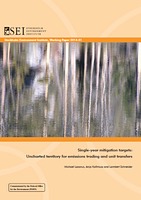Single-year mitigation targets: uncharted territory for emissions trading and unit transfers
 This working paper explores the question of target “time frame” and its implications for the generation and use of tradable emissions units. Under United Nations Framework Convention on Climate Change (UNFCCC) agreements, some countries have adopted continuous or multiple-year emissions targets, while others have taken on discontinuous or single-year targets, most notably for the year 2020. Countries relying solely on single-year targets present greater uncertainty with regard to their emissions pathways, and as examined here, raise concerns regarding both ambition an comparability with other targets. The use of tradable units to meet a single-year target or the issuance of units in years prior to the single-target year could reduce the cumulative mitigation outcome compared with both single-year targets without using tradable units, and multi-year targets (with or without using units). Single-year targets may also limit the ability to use domestic carbon market instruments, such as emissions trading schemes. Continuous multi-year targets provide greater comparability of targets; they provide certainty about cumulative global emissions; they allow an assessment of the progress towards meeting targets; they make countries less vulnerable to changes in climatic or
economic conditions; and they are compatible with domestic and international carbon market instruments, which are key policy tools in many countries for achieving mitigation. Multi-year targets also support the notion of carbon budgets, which is gaining more widespread currency, as seen in the Intergovernmental Panel on Climate Change (IPCC) Fifth Assessment Report.
This working paper explores the question of target “time frame” and its implications for the generation and use of tradable emissions units. Under United Nations Framework Convention on Climate Change (UNFCCC) agreements, some countries have adopted continuous or multiple-year emissions targets, while others have taken on discontinuous or single-year targets, most notably for the year 2020. Countries relying solely on single-year targets present greater uncertainty with regard to their emissions pathways, and as examined here, raise concerns regarding both ambition an comparability with other targets. The use of tradable units to meet a single-year target or the issuance of units in years prior to the single-target year could reduce the cumulative mitigation outcome compared with both single-year targets without using tradable units, and multi-year targets (with or without using units). Single-year targets may also limit the ability to use domestic carbon market instruments, such as emissions trading schemes. Continuous multi-year targets provide greater comparability of targets; they provide certainty about cumulative global emissions; they allow an assessment of the progress towards meeting targets; they make countries less vulnerable to changes in climatic or
economic conditions; and they are compatible with domestic and international carbon market instruments, which are key policy tools in many countries for achieving mitigation. Multi-year targets also support the notion of carbon budgets, which is gaining more widespread currency, as seen in the Intergovernmental Panel on Climate Change (IPCC) Fifth Assessment Report.
